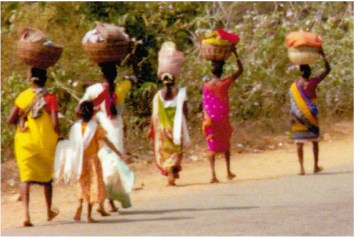
Once again, we parked up the road from the village where we finally stopped. It was market day, so the narrow dirt streets were filling with people who had hiked down from even more remote villages higher in the mountains. Unlike other places we’d visited in this part of Eastern India, foreigners were not particularly welcome.
Men and women had left their homes early in the morning, walking barefoot as far as 20 kilometers through the mountainous jungle, despite the leopards, wild boar, jackals, and other animals that were known to live there. Tigers weren’t often seen in the area, but there were no guarantees.
The women of the tribe were unmistakable: small, dark brown, with delicate features, they looked very different from women of the tribes who had already put out their eggplants, cauliflower, tomatoes, and other produce on pieces of cloth and in baskets set on the dirt. These tiny women wore their fortunes on their bodies, starting with large twisted-aluminum rings around their necks and huge brass earrings. Their shaved heads were covered with many coiled strands of small beads until they seemed to be wearing colorful, close-fitting hats.
They used to be entirely naked except for their ornaments, but now they wore pieces of cloth called lungis wrapped around their waists and sometimes short capes to protect their backs from both sun and jungle. Their almost naked, quite flat, chests were covered with strands of beads, often enhanced with bits of glass and small seashells, that reached to below their waists. Bracelets of multicolored beads decorated their skinny arms and ankles. They carried whatever they intended to sell in bundles on top of their bead-wrapped heads.
Walking through the market, we saw women from a different tribe who wore large brass nose rings. None of them looked like the tribal women we’d seen other places. Very few men from any tribe were visible here--probably back home, drunk on mahua, a fermented drink made from a local tree, although they also made beer from rice or palm sap. As with many tribal societies, the women of these remote Indian villages did most of the work. In one corner of the market, however, a few men were selling several kinds of fish – which were becoming fragrant as the day grew hot.
The home villages of X tribe are spread over a jungle area of more than 15 square kilometers, with a population not more than five or six thousand. None of them wanted the outside world to come to them. Before making the long trip, we’d been warned that they didn’t like either photography or visible cameras.
Times are changing, however, even for them. Their children are starting to go to school and to participate in government programs, such as the free lunches for students. Even this remote tribe may eventually become part of the modern world.
It may give them more options in their lives and make life easier for them. Or will they come to prefer junk food to fresh fruit and vegetables? Will they learn to make cheap trinkets to sell to tourists, forgetting their own culture? Will they want canned entertainment that has nothing to do with their own experiences?
Are the old ways worse, better, or just different than the changes that wait on the horizon? Are the people of this tribe happy, now? Who can say? I don’t think they could say. They’ve never known anything else, until now.
 RSS Feed
RSS Feed